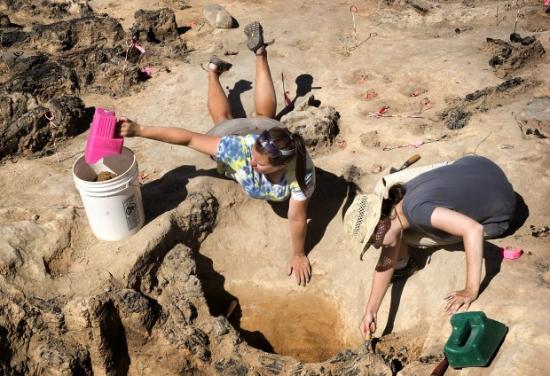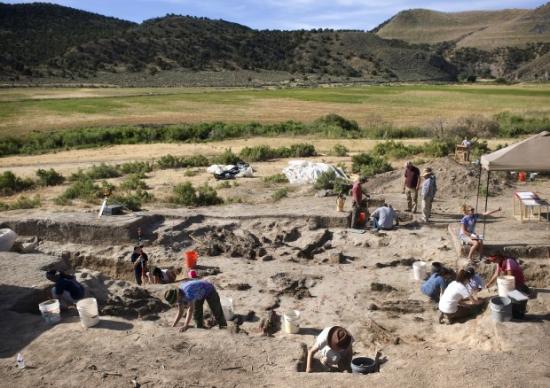Source -http://www.heraldextra.com/news/local/south/goshen/byu-students-excavating-fremont-indian-village-in-goshen/article_3eaaf81b-a4ec-5f8b-8a4e-3e0d06907e2e.html

BYU archeology students are excavating what is said to be the largest Fremont Indian building ever excavated. JAMES ROH/Daily Herald
June 09, 2012 12:25 am • Paige Fieldsted - Daily Herald
Thirty-five miles south of Provo near the sleepy town of Goshen, BYU students and professors are in a flurry of activity, working hard to finish excavating the largest Fremont Indian dwelling ever found.
The students are part of a field study class in the archaeology program at Brigham Young University. This is the fourth year students have been using what is known as Wolf Village in Goshen to get hands-on experience working on a dig.
During last year's dig a large communal-type building was discovered. The building, which is approximately 850 square feet, is the largest Fremont Indian structure found to date and is several times larger than typical Fremont buildings, which average between 80 and 90 square feet.

BYU archeology students are excavating what is said to be the largest Fremont Indian building ever excavated. JAMES ROH/Daily Herald
"The community and what type of community existed is really interesting to me," BYU senior Daniel King said. "This building defies all knowledge of Fremont architecture. It is so cool to study its size and features."
Jim Allison, who oversees the students' work each semester, said the space was likely used for communal purposes. He said what is interesting about this building is the sheer volume of artifacts found on top of the burned-down building.
"From what we can tell it was used as a communal building for a fairly long time before it burned but then I think they kept using the space for communal purposes but without the building," Allison said. "It is a really interesting kind of thing."

Part of an arrowhead found during the excavation . JAMES ROH/Daily Herald
The large building isn't the only excavation being done at the site; two other pit houses also are part of the dig. They are much smaller and more traditional for Fremont structures and are just two of many at the site. Allison said so far they have excavated a total of nine buildings and he believes there are many more nearby.
"Figuring out how large this village was is difficult because the hills are active and dirt is shifting," Allison said. "This central part was completely buried and it isn't easy to tell where structures may be. There could easily be dozens more."
Allison estimated that most of the buildings they are excavating were in use from approximately 1025 to 1125 A.D. but some of the artifacts they have found date back to 700 A.D.
While Allison is excited to learn more about the people that occupied Goshen more than 1,000 years ago the students are excited for the opportunity to get hands-on experience before earning a bachelor's degree.
Students do work the same way it would be done at a professional archeological dig, sectioning off one-meter sections and then digging those sections by removing 10 to 20 centimeters of dirt at a time. The dirt is then sifted looking for artifacts. Students are usually looking for changes in the color and consistency of the dirt to figure out where the walls and the floor of the structures are.
"They are doing all the same things as they would at a professional site," said Mike Searcy, assistant professor in the department of anthropology at BYU. "It is exciting because we are retrieving real data that will be used to do real analysis and research but at the same time giving students the opportunity to excavate and work in the field."
Bailee Isaacson, a senior in archaeology at BYU, said the most important things she has learned at the site aren't related to archaeology at all.
"We have really learned to how to work with other people," Isaacson said. "And we've learned to deal with the changes in weather. Like when it is really hot or windy, sometimes it can be hard to want to keep working."
The students will finish up their work in the next few days before covering their work with plastic tarps and dirt to make it easier for future students to continue excavating.
Searcy said they only do the field class in the spring and then have to cover all their work and leave the ground as close to the way they found it as possible.
Allison is hoping to have the entire large building excavated before the end of spring term so they don't have to re-dig it next year, something he said is a long and difficult task.
Students will continue their work in the fall, though, as they begin analysis on the artifacts they have found.
"It is fun to see the payoff immediately and be able to start to analyze the things we have found," King said. "Then we get to come up with answers and figure out what happened to these people. It is a thrilling chase."